I have been given a number of interesting suggestions for more monster books, among them Creatures of Barsaive for Earthdawn and Creatures of the Dreamseed for Engel, which I am currently trying to hunt down. In the meantime, we’re going to explore Monster of Faerûn, the last Dungeons & Dragons book I have on my list of books I want to cover.
Monsters of Faerûn was one of the very early books for D&D 3rd edition and the first monster book after the original Monster Manual. The cover of the book matches the Monster Manual and not the Forgotten Realms Campaign Setting as all other Forgotten Realms books later would. It is also the only book that has the title “Monster Compendium” in it’s name. I assume it was planned to have it as a distinct product line, but all further monster books were 200+ pages hardcovers, unlike this 100 page paperback.
I started with fantasy stuff in 1999, the year before 3rd edition was released, and that start was Baldur’s Gate, the game that made BioWare the giant of Western RPGs that it had been for until recently. (Really not a fan of any of their games since Mass Effect 2, which is the best videogame of all time!) A game that just so happens to be set in the Forgotten Realms, so I had to get this book right when it came out. And even though it’s by far the smallest monster book ever released by WotC, and also just the second they made, I think this one really the best one by a far margine. When I went to get the monster pictures from the old art archive from WotCs website (they are still up, but you’ll only get there through search engines), there was barely amy that I didn’t download. And most of those that I am not going to cover here aren’t boring, but they are either beefed up versions of monsters from the Monster Manual (cloaker lord, greater doppelganger) or I already covered them when I did the 1st edition Fiend Folio (bullywug, fire newt, giant strider, gibberling, quaggoth). Truly wonderful book and almost all of the creatures can be imported to other settings without problem. I think a good dozen of them directly inspired monsters for my own Ancient Lands setting. If this book were Star Wars, it would be The Empire Strikes Back.
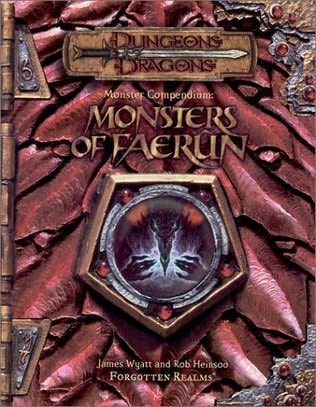
Monster Compendium: Monsters of Faerûn for Dungeons & Dragons 3rd Edition by Wizards of the Coast, 2001; 86 pages of monsters.
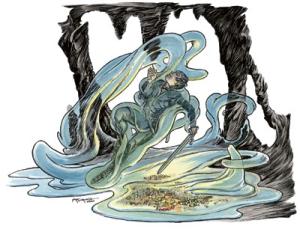
The Aballin is a type of ooze whose most distinguishing trait is that it looks just like water. It also can change between two different states, one being a thick slime, the other a water like liquid that is almost impossible to harm. It is one of the many classic creatures of the type “everything is trying to kill you”, but I think actually one of the less implausible ones. It’s just another slime like all the others, except that it has a clear color. When in its semisolid state, an aballin is quite strong and can slam enemies with considerable force. However its main mode of attack is to engulf its victim and simply drown him.
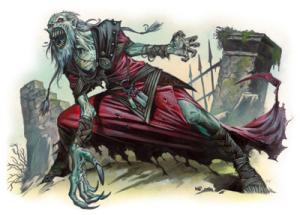
The Banedead is a variant ghoul created by clerics of the evil god Bane. One of their hands is a large claw, which also happens to be the holy symbol of Bane, and also deals 1 point of Dexterity damage. Which is not as measly as it sounds. Since it’s tied to a melee attack, there is no saving throw and there’s a good chance you’re going to encounter them in significant numbers. This can get quite bad over time, especially as banedead are not very strong otherwise and therefore likely to be fought by PCs of low-medium level. Dealing with larger numbers of them over several encounters could make for a very interesting adventure. An interesting detail of the banedead is that they are also created by priests of the Banes son Xvim, which tells us that this book was actually released before the FRCS, as from that point on Xvim is dead and Bane is back! (Variant Ghoul +1)
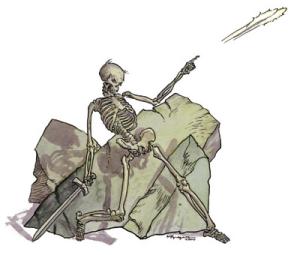
The Baneguard is another undead creature created by the clerics of Bane. It looks like an ordinary skeleton, but is both tougher and far more intelligent. In addition they can shot two magic missiles every three round and use the spell blink every 10 minutes, which makes them randomly fade in and out of the ethereal plane, making it very difficult to hit them. This really is a very simple creature as special abilties go, but the result is something completely different from a normal skeleton. A great example of how you don’t need a full page of stats and 30 spell-like abilities to make an interesting monster. And I think a skeleton that shots magic missiles is really cool.
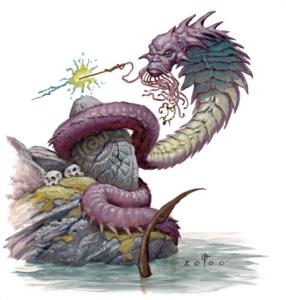
A Banelar is a huge snake monster with a humanlike face, similar to naga. They are extremely intelligent in addition to being of massive size with a Strength and Constitution to match, and they are also always at least 6th level clerics and 6th level wizards. Which makes it absolutely mind-boggling that this is supposed to be a CR 5 creature. To get a human character with comparable stats and abilities, he would have to be 12th level. This looks more like CR 8 or 9 to me. The banelar also gets a +3 bonus on saving throws against petrification. That’s random. The banelar are not demons in the service of the god Bane, but many of them used to be allied with clerics who served him, and now switched their allegiance to followers of Cyric. However, this was while Bane was still dead, and I think they switched back when he returned. They are in some way involved with the internal politics of the Zhentarim, a powerful criminal organization in which the clerics of Bane had a very big influence, and which had a kind of civil war when Bane was killed and his clerics were devided into followers of the new gods Cyric and Xvim. And given that I’ve never seen banelars anywhere else, except as an updated stat block for the D&D 3.5 edition, I suspect very strongly that these are from either a 2nd edition adventure or from a novel. I still think they are quite interesting, being these huge and very smart snakes who are actively involved in the poltics of evil temples and criminal organizations.
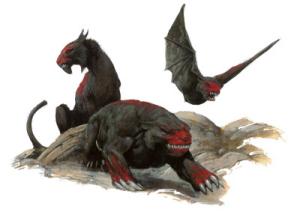
Beasts of Malar are awesome. The illustration alone is enough to make me want to use something like this in my games, and the description and abilities aren’t bad either. Malar is the Faerûnian god of Hunt and Slaughter, and the Beasts of Malar are incarnations of just that. While not terribly big, these things are the ultimate killing machines. Not only arge they extremely strong and tough, they are alost just as intelligent as humans. There is in fact only a single type of beast, but they are shapechangers who can shift between the forms of a big cat, a wolverine, and a bat. They have black fur and always appear to have their faces, paws, and back splattered in blood, and all forms have huge teeth and claws. They can only be hurt by magical weapons, but even then they regenerate almost all wounds very quickly and can only be destroyed with the magic of a priest or druid or blessed weapons. There isn’t really much to them, but I think other than being sized up to Large, I wouldn’t really change aynthing. These are totally mean looking things of blood rage with huge teeth! What more could you want?
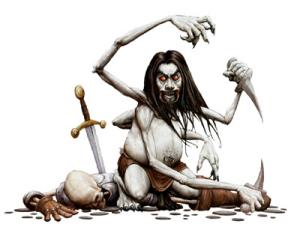
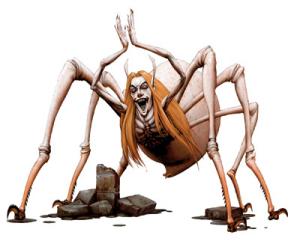
The Chitine is one of my favorite D&D monsters and one of the things that make me see the Forgotten Realms as more than just a “generic fantasy setting”, which it really isn’t. It’s not even “generic D&D”. Chitines are a race of humanoids that are somewhat smaller than humans and have six long arms and insect like eyes and mouths. Other than being trained in using three weapons at once and having an aversion to very bright light, they don’t really have any notable special abilities. While they look savage and live in relatively simple villages deep below the ground, they are actually even smarter than most humans. They don’t have any wizards for some reason, but are lead by the Choldrith, who look even more like spiders and are priestesses of the evil spider goddess Lolth. The chitines are said to have been originally created by the drow as slaves, but even though the two races serve the same deity, they have a deep hatred and hostility for each other and are mortal enemies. They have been around in D&D for much longer than 3rd edition, but I’ve never actually seen them appear in any sourcebooks or adventures for 2nd edition, while they had plenty, if admitedly minor appearances in 3rd edition. I am not quite sure what I find so compelling about them, but I think part of it is the idea of having a humanoid race of similar size and abilities to human, which at the same time is also highly inhuman.
